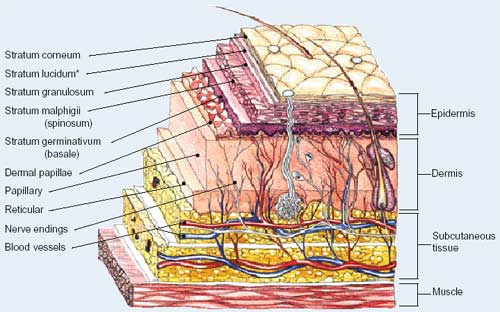The skin consists of three basic layers: the epidermis, dermis, and hypodermis. Within these layers, there are other layers as well. The epidermis is composed of five layers: stratum basale (basale layer), stratum spinosum (prickly layer), stratum granulosum (granular layer), stratum lucidum (clear layer), and stratum corneum (horny layer). These five layers contain four distinct cell types, including melanocytes, Merkel cells, Langerhan's cells, and keratinocytes. The dermis consists of two layers: the papillary and reticular layers. There are other components to the skin as well, such as sweat glands, blood vessels, and hair follicles. The skin layers, under normal conditions, are shown below.
The picture below illustrates the process of dying the skin through tattoos. The needle pierces the epidermis and injects ink into the dermis in the papillary layer. The needle is motorized, puncturing the skin between 50 and 3,000 times per minute, depositing ink with every puncture. The ink can then be seen through the epidermis, and due to the stability of the cells in the dermis, the ink does not travel or fade in the skin.
The last condition we are going to look at is electrolysis, or laser hair removal. In this case, a needle is inserted into the skin to come in contact with a hair follicle. An electrical shock is transmitted to the base of the follicle, causing it to reach a temperature in which hair growth is irreversibly inhibited. The epidermis, located below, remains undamaged.
The picture below illustrates the process of dying the skin through tattoos. The needle pierces the epidermis and injects ink into the dermis in the papillary layer. The needle is motorized, puncturing the skin between 50 and 3,000 times per minute, depositing ink with every puncture. The ink can then be seen through the epidermis, and due to the stability of the cells in the dermis, the ink does not travel or fade in the skin.
In the next picture, the integumentary system's reaction to poison ivy is displayed. An irritant from the ivy is transferred to the epidermis where it immediately triggers a reaction. Effector T cells signal white blood cells to attack the site of intrusion. A water soluble, nonallergenic compound is then formed, which prevents further allergic response. The Effector T cells then stop signaling the white blood cells, and natural antiseptic properties sanitize the rash, which is healed within 3 days.
The last condition we are going to look at is electrolysis, or laser hair removal. In this case, a needle is inserted into the skin to come in contact with a hair follicle. An electrical shock is transmitted to the base of the follicle, causing it to reach a temperature in which hair growth is irreversibly inhibited. The epidermis, located below, remains undamaged.
http://www.follikill.com/wp-content/uploads/2014/01/how-laser-hair-removal-work1.jpg
I hope you enjoyed learning about the integumentary system!
I hope you enjoyed learning about the integumentary system!





No comments:
Post a Comment